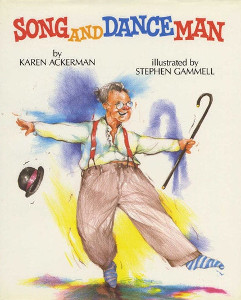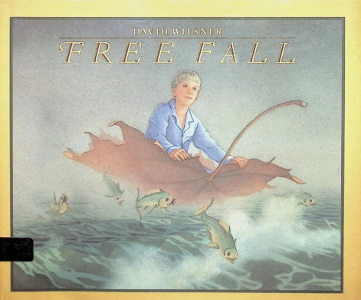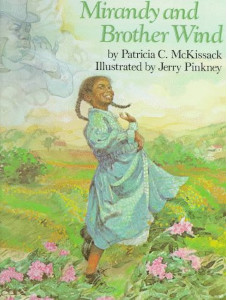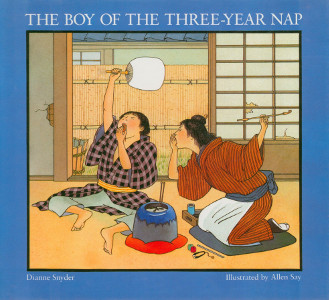
Song and Dance Man
By: Karen Ackerman
Illustrated by: Stephen Gammell
Medal Winner
NOT REVIEWED
When his grandchildren follow Grandpa up the attic stairs, a dazzling show, better than any on TV, is about to begin! Grandpa opens a dusty trunk, pulls out bowler hat and gold-tipped cane, and suddenly we are back in the good old days, the song and dance days. The lights are twinkling, and a vaudeville man is doing the first slippery steps of the old soft shoe. . . .
So sit right back and enjoy the show as Karen Ackerman and Stephen Gammell's warm, wondrous Grandpa brings new life to days gone by.
From the dust jacket
The Boy of the Three-Year Nap
By: Dianne Snyder
Illustrated by: Allen Say
Honor
NOT REVIEWED
The laziest person in the village is certainly the boy of the three-year nap. As he lounges and dozes in the garden, he dreams of somehow gaining a fortune without lifting a finger.
During those rare moments of wakefulness, he watches a rice merchant build a mansion next door, and hatches a plan to marry the beautiful daughter. What better way for a penniless, lazy boy to become wealthy?
And what better way to trounce a trickster than to turn the tables on him? In this traditional Japanese folktale, Dianne Snyder relates a humorous match of wit for wile to show that laziness does not pay. . .or does it?
Allen Say brings a special insight and Eastern flavor to Dianne Snyder's adaptation with artwork done in brush line and vibrant color reminiscent of the master Japanese painters.
From the dust jacket

Free Fall
By: David Wiesner
Honor
Reviewed by: Sherry Early
This wordless picture book was donated to my library. I had never seen it before, but I picked it up to show to my five year old granddaughter. She immediately engaged with the story and delighted in the idea that she could “read” this book herself by telling the story that she saw in the pictures. This kind of reading seems like good practice for Charlotte Mason-style narration and picture study if that is what you want to use as a learning tool later on your child’s education.
The first page of this book shows a boy asleep in bed with an open book on his chest. He’s obviously fallen asleep while reading. On the next page, we see that the book is a book of maps, and one of the pages floats out into the outdoors. Perhaps into the boy’s dreams?
Read full review
Goldilocks and the Three Bears
By: James Marshall
Honor
NOT REVIEWED
Papa Bear, Mama Bear, and little Baby Bear were mighty hungry after their morning ride. But when they returned to their beautiful Victorian home, it was in a terrible state! Their porridge, left cooling on the dining room table, had been eaten. Baby Bear's chair was broken into little pieces. And upstairs the intruder still slept. Who would have thought that one little girl could cause such pandemonium?
James Marshall, original and irreverent as always, enriches this familiar tale with inventive touches that will have readers—both young and old—clutching their sides with merriment.
Some picture books are much too hard. Some picture book are much too soft. But James Marshall's Goldilocks is just right.
From the dust jacket of a later printing

Mirandy and Brother Wind
By: Patricia C. McKissack
Illustrated by: Jerry Pinkney
Honor
Reviewed by: Lara Lleverino
Also read by: Sandy Hall
This imaginative story is a window into another time and a specific culture. McKissack lets the reader peak into the life of a young African American girl in the southern United States as she interacts with her community. Mirandy is looking forward to a local "cake walk" in which she will dance and by impressing the elders of her community with her style will win the cake. The text is full of picturesque language that helps you to see and feel Mirandy's anticipation of winning. Her interactions with the members of her community provide a rich tapestry for the simple story to take place. Mirandy's friendship with the awkward Ezel is a prime opportunity to discuss with a child the nuances of friendships and loyalties. The phonetically written conversational speech between Mirandy and her elders provides an auditory context that blends well with Jerry Pinkney's heartwarming illustrations. Readers might want to be aware that Mirandy consults a "conjure woman" for a spell that the old woman gets from an old book to help Mirandy capture the wind, which Mirandy thinks she needs to win the dance contest. The conjure woman questions why Mirandy has come to her since Mirandy's people would not approve. The spell is ultimately a failure, but in payment Mirandy has to take two scarves from the conjure woman and wear one on each arm as she dances.




